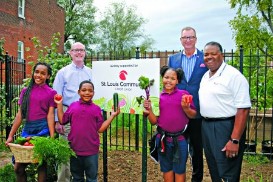
This article was written by Rachel Witt, Executive Director of the South Grand Community Improvement District. Read all the articles in Rachel’s Lessons & Partnerships in Community & Economic Development series.
To rebuild a city requires many partners within a community. How do we connect our community? A community is connected through the partnership of nonprofits, business leaders, and universities, with the support from local government.
The makeup of a community plays a role in how one will rebuild a community. A successful main street encourages investment with its partners from rehabbing homes to employment opportunities. For example, having a main street surrounded by many variations of housing such as four-family, two-family, single-family, and apartment buildings encourages mixed-income communities.
It is key to have mixed-income within a neighborhood to build inclusion, but this is not an easy process. Planning and zoning and the proper tax incentives must all work in harmony for success. Most of all, working with housing nonprofit corporate partners is crucial to provide affordability with mixed incomes.
Housing nonprofit corporations’ core goals are to engage in revitalizing neighborhoods with support from business leaders, universities, and banks. By connecting universities and business leaders to declining neighborhoods, the tools to elevate and succeed are provided. Mixed-income communities are the key to success.

Universities are invested in communities through real estate, housing programs, incentives for their faculty and staff to live near the university as well they support outreach to help low income families with job fairs, training and partnership with nonprofits to ensure stability in employment opportunities. Many business leaders partner with universities through financial assistance, job fairs, training, and mentorship programs.
Rebuilding is not a sprint it is a marathon it takes time. Changing the makeup of a neighborhood needs to be gradual and orchestrated so that the community gets involved and engaged. When changes are pushed too quickly, residents feel they are being forced out. The goal is to always help the community grow. Providing tools instead of a handout is the most prosperous economic tool that benefits everyone.
Most of all hope is needed. When there is hope determination will follow with tools of: education, training, and employment with the assistance of childcare is needed for success. Other key factors are to have specific nonprofits involved with their core goals are to engage in revitalizing neighborhoods. By connecting universities and business leaders to declining neighborhoods will provide the tools to elevate and succeed.
Lastly, what makes a neighborhood a success is the relationship amongst its partners. Neighborhood associations, housing nonprofit corporations, aldermen, city departments, and business districts are the key components to rebuilding a City with partners.
 Rachel Witt is the Executive Director of the South Grand Community Improvement District. Graduate from Southern Illinois University Edwardsville with a Bachelor of Science Degree in Geography, minor in Sociology and certification in Nonprofit Management. Master’s in public administration from Widener University emphasis in local government and economic development. Connect with Rachel on Linkedin or Email.
Rachel Witt is the Executive Director of the South Grand Community Improvement District. Graduate from Southern Illinois University Edwardsville with a Bachelor of Science Degree in Geography, minor in Sociology and certification in Nonprofit Management. Master’s in public administration from Widener University emphasis in local government and economic development. Connect with Rachel on Linkedin or Email.
